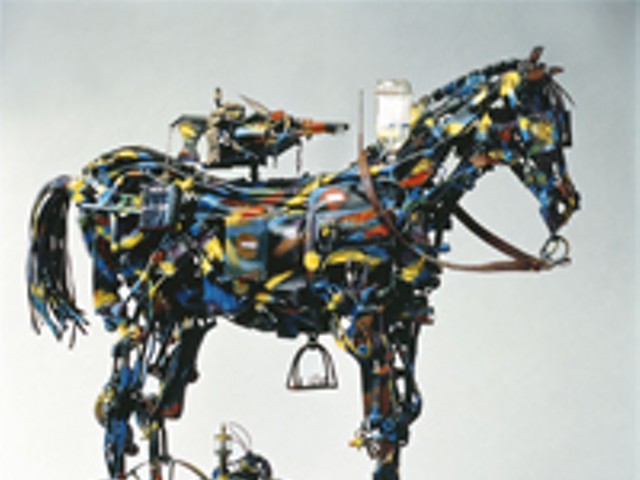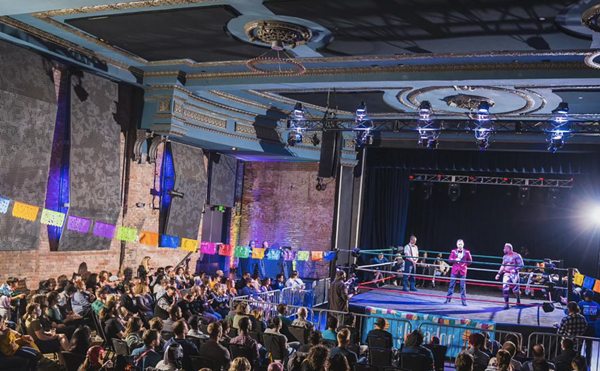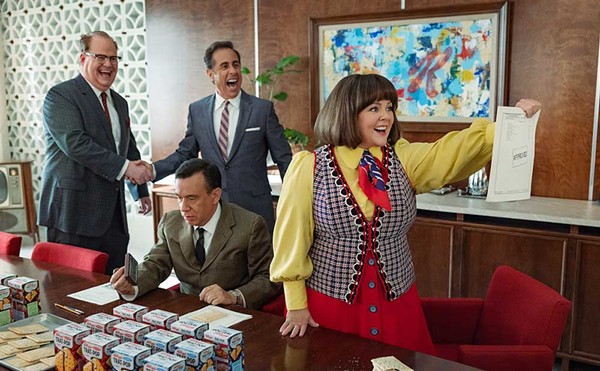His amusing, quirky art filling the gallery says the same thing; Charara incorporates playfulness into his work, even when he’s taking on serious social issues. All of his stuff is this way — from the cut-up bingo cards and little doodles in his works on paper to the googly-eyed family of sculptural creatures. His liveliness also has something to do with the fact that he’s a dad who likes making his daughters laugh.
After living in Sierra Leone, Lebanon, Seattle and Boston, Charara moved with his family to Dearborn roughly 10 years ago, when his parents retired there. Before that move, he didn’t know many other Arab-American artists, yet just a week after his solo show opened in late March, Arab-American artists, musicians, educators, writers and bloggers packed in the museum to participate in the Diwan conference and check out Charara’s show. As for the label of “Arab-American artist,” which seems to be sticking, he says, “People always want to put a label on you, but I can’t deny that I am an Arab-American artist, and I don’t want to deny it. I’m proud of it.”
The exhibition statement for Juxtaposed concludes with a nice idea: “Explore this exhibition with your own experiences of identity and culture to form your personal connection with these works.” Seeing the sculptures, paintings, works on paper and video documentary is like traveling as an immigrant through a strange world and interpreting it through your own eyes, rather than being overwhelmed by the artist’s vision.
As soon as I saw the envelopes, peeled apart, covered in foreign stamps and little doodles, hanging on the wall, I was transported back to childhood, remembering a fragment of my own Arab-American experience: the red, white and blue international envelopes we’d get in the mail, filled with new baby photos, letters full of family gossip, and important official documents, sent from far away. Like the title of one of Charara’s mixed-media envelopes, “You Cannot Run Away From Home,” the letters followed us wherever we moved. Its contents were so precious, but the envelope always ended up in the trash. Charara rescues the thing that has been discarded and imbues it with value, transforming it into something worthy of framing and displaying in a museum. This theme carries over into his sculptures, made from such old and broken household items as hammers and bent forks, and an architect’s protractors, rulers and compasses (he was once an architecture student), as well as the remains of old brushes and other art supplies.
Initially, the idea for the envelope series was “Return to Sender,” referring to the repatriation of freed slaves from the United States to Africa, in particular Sierra Leone, where Charara grew up. In Juxtaposed!, this theme extends to represent the immigrant experience as well. The envelopes are metaphors for people who traveled long distances, starting out fresh with anticipation and arriving haggard, worse for the wear. For Arab-Americans in particular, as well as other groups often assumed to be Arab or Muslim, the theme of “Return to Sender” also alludes to a strong sentiment in this post 9/11 world: “Go back where you came from.”
Charara, 45, has no formal training in visual art. He often references his background in architecture by mixing two- and three-dimensional media. His paintings have sculptural elements, with pieces of wood extending beyond the canvas edge. Also, Charara often incorporates the motif of city buildings. He says, “As I mature as an artist, I notice the relationship between visual symbols and motifs in my work, and my identity and history.” At first he didn’t think to compare the continuous line he uses in both his drawings and paintings to Arabic script and Islamic calligraphy — sometimes twisting and organic, other times structured and geometric. While some would notice a cubist influence and a connection to Picasso in Charara’s paintings and drawings, he had been breaking things up into planes the same way, long before he had ever seen or heard of Picasso. In fact, his upbringing in Sierra Leone acquainted him with the African art that actually inspired Picasso and other cubist artists. His sketchbooks are included in the exhibition, under glass and with pages open to drawings of African masks.
While the exhibition refers to the immigrant experience, not specifically the Arab-American experience, Charara says he has another project in the works about Arab hospitality. Typically, when you enter an Arab’s home as a guest you are immediately served coffee, tea or sometimes even Tang. Fadl, which means something like “Go ahead, help yourself,” will be a series of paintings made from the coffee and tea that remains in his guests’ cups after they have finished drinking. The idea is another example of Charara’s inclination to rescue things from being discarded. “I want to highlight the best things about the culture,” he says, as a most gracious host.
Juxtaposed! runs through May 31 at the Arab American National Museum, 13624 Michigan Ave., Dearborn; 313-624-0234; www.arabamericanmuseum.org.
Nadia Abou-Karr recently received her bachelor’s of fine art in printmaking from Wayne State University. Send comments to [email protected]




